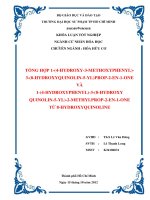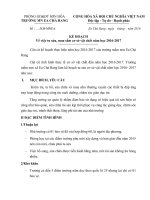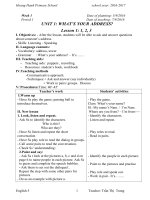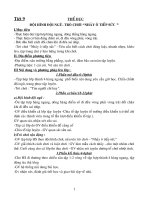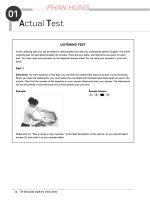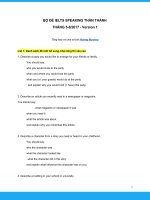5 APAPARI 2017 asthma en
Bạn đang xem bản rút gọn của tài liệu. Xem và tải ngay bản đầy đủ của tài liệu tại đây (3.91 MB, 81 trang )
APAPARI Workshop Hanoi 2017
Approach to asthma in
children
Dr. Michael Lim
Division of Paediatric Pulmonary and Sleep
Khoo Teck Puat - National University Children’s Medical
Institute
(KTP-NUCMI)
National University Hospital Singapore
29th April 2017
Definition of asthma
Definition of asthma
• Asthma is a heterogeneous disease, usually
characterized by chronic airway inflammation
• Defined by the history of respiratory
symptoms such as wheeze, shortness of
breath, chest tightness and cough that vary
over time and in intensity, together with
variable expiratory airflow limitation
GINA 2015
Definition of asthma
• Physiology: Episodic airway obstruction
characterised by expiratory airflow limitation
• Clinical manifestation: Recurrent wheeze,
cough or breathlessness, particularly at night
or early morning
• Often reversible
Definition of asthma
• Pathology: Airway inflammation, airway
structural changes
Stephen T. Holgate & Riccardo Polosa
Nature Reviews Immunology 8, 218-230 (March 2008)
Pathophysiology of asthma
Trends in Microbiology, July 2015, Vol. 23, No. 7
ICON Allergy 2012
Making the diagnosis
History
• Recurrent respiratory symptoms (wheeze,
cough, dyspnea, chest tightness)
– typically worse at night/early morning
– exacerbated by exercise, viral infection, smoke,
dust, pets, mold, dampness, weather changes,
laughing, crying, allergens
• Personal history of atopy (eczema, food
allergy, allergic rhinitis)
• Family history of asthma or atopic
diseases
ICON 2012
Physical examination
• Chest auscultation for wheezing
• Symptoms/signs of other atopic diseases such
as rhinitis or eczema
ICON 2012
Investigations
• Evaluation of lung function (spirometry with reversibility
testing, preferred to PEFR, which can nevertheless be used
if resources are limited
• Evaluation of atopy (skin prick tests or serum-specific IgE)
• Studies for exclusion of alternative diagnoses (e.g. chest Xray)
• Therapeutic trial
• Evaluation of airway inflammation (FeNO, sputum
eosinophils)
• Evaluation of bronchial hyperresponsiveness (nonspecific
bronchial challenges, e.g. methacholine, exercise)
ICON 2012
Asthma management in children
Basic approach to asthma hasn’t
changed – a holistic approach
•
•
•
•
•
Control symptoms
Lead a normal active life
Normal lung function
Prevent asthma exacerbations
Asthma medication – prescription, convince and
educate families about giving medicines properly
• Avoid or handle triggering factors, including
exercise
• Recognise signs that asthma is worsening
• Seek medical advice when needed
Characteristic
Levels ofAsthma
Control
Controlled
Partly controlled
(All of the following)
(Any present in any week)
Daytime symptoms
None (2 or less /
week)
More than
twice / week
Limitations of
activities
None
Any
Nocturnal
symptoms /
awakening
None
Any
Need for rescue /
“reliever” treatment
None (2 or less /
week)
More than
twice / week
Lung function
(PEF or
FEV1)
Normal
< 80% predicted or
personal best (if
known) on any day
Exacerbation
None
One or more / year
week
Uncontrolled
3 or more
features of
partly
controlled
asthma
present in
any week
1 in any
GINA assessment of asthma control
Asthma symptom control
Level of asthma symptom control
In the past 4 weeks, has the child had
Well
Controlled
Partly
controlled
None of
these
1-2 of
these
Uncontrolled
Daytime symptoms > 2/week
Any night waking due to asthma?
Reliever needed for symptoms >2/week
3-4 of these
Any activity limitation due to asthma
Risk factors for poor asthma outcomes
Excessive use of SABA
Inadequate ICS – Inappropriate dosage, poor adherence or incorrect inhaler technique
Low FEV1
Major psychological or socioeconomic problems
Exposures – smoking, allergen exposure
Co-morbidities – Obesity, rhinosinusitis
> 1 severe exacerbation in the last 12 months
Pharmacotherapy
ICON Allergy 2012
Stepwise approach to control asthma symptoms
and reduce risk
Diagnosis
Symptom control & risk factors
(including lung function)
Inhaler technique & adherence
Patient preference
Symptoms
Exacerbations
Side-effects
Asthma medications
Patient satisfaction
Non-pharmacological strategies
Lung function
Treat modifiable risk factors
STEP 5
STEP 4
PREFERRED
STEP 1
STEP 2
CONTROLLER
CHOI
CE
Other
controller
opt
ions
RELIEVER
REMEMBER
TO...
SLIT added as
an option
GINA 2017, Box 3-5
Low dose ICS
Consider low
dose ICS
Leukotriene receptor antagonists (LTRA)
Low dose theophylline*
As-needed short-acting beta2-agonist (SABA)
•
•
STEP 3
Refer for addon treatment
Med/high
ICS/LABA
Low dose
ICS/LABA**
Med/high dose ICS
Low dose
ICS+LTRA (or +
theoph*)
e.g.
tiotropium,*
anti-IgE,
anti-IL5*
Add tiotropium*Add low dose
High dose ICS
OCS
+ LTRA
(or + theoph*)
As-needed SABA or
low dose ICS/formoterol#
Provide guided self-management education (self-monitoring + written action plan + regular review)
Treat modifiable risk factors and comorbidities, e.g. smoking, obesity, anxiety
•
Advise about non-pharmacological therapies and strategies, e.g. physical activity, weight loss, avoidance of
sensitizers where appropriate
•
Consider stepping up if … uncontrolled symptoms, exacerbations or risks, but check diagnosis, inhaler
technique and adherence first
•
Consider adding SLIT in adult HDM-sensitive patients with allergic rhinitis who have exacerbations despite
ICS treatment, provided FEV1 is >70% predicted
•
Consider stepping down if … symptoms controlled for 3 months + low risk for exacerbations.
Ceasing ICS is not advised.
© Global Initiative for Asthma
What’s new in GINA
• Add-on tiotropium by soft-mist inhaler is a new
‘other controller option’ for Steps 4 and 5, in
patients ≥18 years with history of exacerbations
• Tiotropium - long-acting once-daily
anticholinergic
– Initially used in COPD
– Benefits shown in adult asthma
Benefit of tiotropium in adolescent
and pediatric lung function
In studies of symptomatic 6- to 11year-old and 12- to 17-year-old
asthmatic patients receiving at least
an ICS, tiotropium improved peak and
trough FEV1 and morning and
evening PEF
Vogelberg et al. Respiratory Research
• Studies have not yet investigated the effect of
tiotropium on asthma exacerbations in paediatric and
adolescent patients
• As add-on to conventional Rx, no statistically
significant
improvement in asthma control with tiotropium
Stepwise management, SLIT as an add-on option
for some patients
REMEMBER
TO...
• Provide guided self-management education
• Treat modifiable risk factors and comorbidities
• Advise about non-pharmacological therapies and strategies
• Consider stepping up if … uncontrolled symptoms, exacerbations or risks,
but check diagnosis, inhaler technique and adherence first
• Consider adding SLIT in adult HDM-sensitive patients with allergic rhinitis who
have exacerbations despite ICS treatment, provided FEV1 is 70% predicted
• Consider stepping down if … symptoms controlled for 3 months
+ low risk for exacerbations. Ceasing ICS is not advised.
SLIT: sublingual immunotherapy
GINA 2017, Box 3-5 (3/8) (lower part)
© Global Initiative for Asthma
Allergen specific immuno-therapy
(SCIT/SLIT) in asthma with rhinitis
• Administration of increasing doses of allergen extracts to
induce persistent clinical tolerance in patients with allergeninduced symptoms
• Effective in improving rhinitis
• Adults and adolescents with allergic rhinitis known to be more
likely to have increased bronchial hyper-responsiveness
• Evidence that 3-year SCIT can reduce the development of
asthma symptoms and improved bronchial responsiveness1
• May prevent development of sensitisation to additional
allergens2
1. Moller J Allergy Clin Immunol 2002
2. Pajno Clin Exp Allergy 2001
